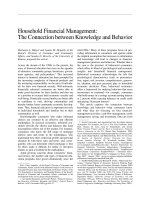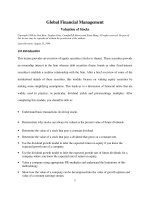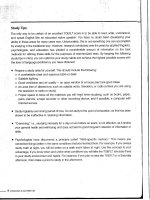Tài liệu Household Financial Management: The Connection between Knowledge and Behavior doc
Bạn đang xem bản rút gọn của tài liệu. Xem và tải ngay bản đầy đủ của tài liệu tại đây (91.73 KB, 14 trang )
Household Financial Management:
The Connection between Knowledge and Behavior
Marianne A. Hilgert and Jeanne M. Hogarth, of the
Board’s Division of Consumer and Community
Affairs, and Sondra G. Beverly, of the University of
Kansas, prepared this article.
Across the decade of the 1990s to the present, the
issue of financial education has risen on the agendas
of educators, community groups, businesses, govern-
ment agencies, and policymakers.
1
This increased
interest in financial education has been prompted by
the increasing complexity of financial products and
the increasing responsibility on the part of individu-
als for their own financial security. Well-informed,
financially educated consumers are better able to
make good decisions for their families and thus are
in a position to increase their economic security and
well-being. Financially secure families are better able
to contribute to vital, thriving communities and
thereby further foster community economic develop-
ment. Thus, financial education is important not only
to individual households and families but to their
communities as well.
Knowledgeable consumers who make informed
choices are essential to an effective and efficient
marketplace. In classical economics, informed con-
sumers provide the checks and balances that keep
unscrupulous sellers out of the market. For instance,
consumers who know the full range of mortgage
interest rates and terms in the marketplace, who
understand how their credit-risk profile and personal
situation fit with those rates and terms, and, conse-
quently, who can determine which mortgage is best
for them make it difficult for unfair or deceptive
lenders to gain a foothold in the marketplace.
Amid growing concerns about consumers’ finan-
cial literacy, the number and types of financial edu-
cation programs have grown dramatically since the
mid-1990s.
2
Many of these programs focus on pro-
viding information to consumers and operate under
the implicit assumption that increases in information
and knowledge will lead to changes in financial-
management practices and behaviors. Whether that is
the case is the province of behavioral economics,
which offers its blend of psychological and economic
insights into household financial management.
Behavioral economics acknowledges the role that
psychological characteristics (such as procrastina-
tion, regret, risk aversion, compulsiveness, generos-
ity, altruism, and peer pressure) play in household
economic decisions. Thus, behavioral economics
offers a framework for studying behaviors that seem
inconsistent or irrational—for example, consumers
who hold money in a savings account earning interest
at 2 percent while carrying balances on credit cards
and paying 18 percent interest.
3
This article explores the connection between
knowledge and behavior—what consumers know
and what they do—focusing on four financial-
management activities: cash-flow management, credit
management, saving, and investment. Data are from
Note. Chris Anguelov, of the Board’s Division of Consumer and
Community Affairs, assisted with additional analysis of the Survey of
Consumer Finances data. Jane Schuchardt and Sommer Clarke, of the
U.S. Department of Agriculture, and Manisha Sharma, of the Board’s
Division of Consumer and Community Affairs, contributed to the
development of the survey design and questionnaire.
1. See Sandra Braunstein and Carolyn Welch, ‘‘Financial Literacy:
An Overview of Practice, Research, and Policy,’’ Federal Reserve
Bulletin, vol 87 (November 2002), pp 445–57.
2. Several researchers and organizations have developed catalogs
of programs. For examples, see Lois A. Vitt, Carol Anderson, Jamie
Kent, Deanna M. Lyter, Jurg K. Siegenthaler, and Jeremy
Ward, Personal Finance and the Rush to Competence: Financial
Literacy Education in the U.S. (Fannie Mae Foundation, 2000)
(www.fanniemaefoundation.org/programs/pdf/rep_finliteracy.pdf);
Katy Jacob, Sharyl Hudson, and Malcolm Bush, Tools For Survival:
An Analysis of Financial Literacy Programs for Lower-
Income Families (Chicago, Ill.: Woodstock Institute, 2000);
Jump$tart Coalition, Jump$tart Personal Finance Clearinghouse
(www.jumpstart.org/mdb/jssearch.cfm); National Endowment for
Financial Education, ‘‘Economic Independence Clearinghouse’’
(2001) (www.nefe.org/amexeconfund/index.html); Neighborhood
Reinvestment Corporation NeighborWorks
®
, ‘‘Annotated Refer-
ence Guide for the NeighborWorks
®
Campaign for Home Owner-
ship 2002’’ (August 2001) (www.nw.org/network/pubsAndMedia/
publications/catalog/pubs/annoRefGuide.pdf).
3. Sendhil Mullainathan and Richard H. Thaler, ‘‘Behavioral Eco-
nomics,’’ National Bureau of Economic Research Working Paper
no. w7948 (National Bureau of Economic Research, October 2000)
(www.nber.org/papers/w7948); Amos Tversky and Daniel Kahneman,
‘‘Rational Choice and the Framing of Decisions,’’ Journal of Busi-
ness, vol. 59 (October 1986), pp. S251–278; Amos Tversky and
Daniel Kahneman, ‘‘Loss Aversion in Riskless Choice: A Reference-
Dependent Model,’’ Quarterly Journal of Economics, vol. 106
(November 1991), pp. 1039–61; Thomas Gilovich, Dale Griffin, and
Daniel Kahneman, eds., Heuristics and Biases: The Psychology of
Intuitive Judgement (Cambridge: Cambridge University Press, 2002).
the University of Michigan’s monthly Surveys of
Consumers conducted in November and December
2001 (see Appendix A: Survey Data). Also, data
from the Survey of Consumer Finances (SCF) are
used for purposes of comparison.
4
H
OUSEHOLD
F
INANCIAL
-M
ANAGEMENT
P
RACTICES
Households in the Surveys of Consumers reported on
eighteen financial-management behaviors, ranging
from very basic money management skills (tracking
expenses, paying bills on time) to more sophisticated
ones (diversifying investments). They also provided
information on their use of thirteen financial prod-
ucts. These ranged from savings and checking
accounts to credit cards, mortgages, home equity
loans, and investments. To look at the different
types of financial practices, measures of financial-
management behaviors and financial product owner-
ship were combined.
5
Practices were categorized as
cash-flow management, credit management, saving,
investment, and other. Table 1 lists the behaviors or
products used to analyze each type of practice.
A fairly large percentage of individuals reported
what are considered ‘‘good’’ cash-flow management
practices: 89 percent of households had a checking
account, 88 percent paid all their bills on time, and
75 percent reconciled their checkbook every month.
However, fewer than half reported using a spending
plan or budget. For the credit management practices,
although nearly four-fifths of respondents had a credit
card, only one-third compared offers before applying
for a card. As to saving practices, the data show
that while 80 percent and 63 percent had a savings
account and an emergency fund, respectively, only
39 percent were saving for long-term goals, such as
for education, a car, or a home. There was also a wide
range in the investment practices reported by house-
holds. For example, although three-fifths (63 percent)
reported having retirement accounts—pensions,
401(k), or IRA plans—and half (52 percent) had
investment accounts, less than half (46 percent) said
that they had mutual funds, about one-fourth reported
holding individual stocks, and about one-fifth said
that they put money in other retirement accounts.
6
Of
all the behaviors, reading about money management
was the least frequently reported (20 percent).
Financial Practices Indexes
To characterize the extent of a household’s participa-
tion in each type of financial-management activity, an
4. The SCFs are triennial surveys sponsored by the Federal Reserve
and provide detailed information on the financial characteristics of
U.S. households, particularly families’ assets and liabilities. For
details on the SCF, see Ana M. Aizcorbe, Arthur B. Kennickell, and
Kevin B. Moore, ‘‘Recent Changes in U.S. Family Finances: Evidence
from the 2001 Survey of Consumer Finances,’’ Federal Reserve
Bulletin, vol. 89 (January 2003), pp. 1–32. The definitions of house-
hold in the SCF and in the Surveys of Consumers are consistent
enough to allow for comparisons. In this article, we use the terms
family and household interchangeably.
5. The decision to own a financial product can itself be considered
a financial behavior.
6. To determine the proportion of respondents contributing to
retirement accounts, we included only individuals less than 65 years
old because we assume that individuals 65 or older no longer contrib-
ute to a retirement account. Although we would also like to have made
this calculation conditional on employment status, this variable was
not available in the data set.
1. Financial behavior and product variables used to
analyze cash-flow management, credit management,
saving, and investment practices
Financial behavior or product
Percentage of
respondents
reporting
(n = 1,004)
Cash-flow management
Have checking account ................................. 89
Pay all bills on time .................................... 88
Have financial recordkeeping system or track expenses . . . 79
Reconcile checkbook every month ...................... 75
Use a spending plan or budget .......................... 46
Credit management
Have credit card ....................................... 79
Pay credit card balances in full each month .............. 61
Review credit reports ................................... 58
Compare offers before applying for a credit card ......... 35
Saving
Have savings account .................................. 80
Have emergency fund .................................. 63
Save or invest money out of each paycheck
1
............ 49
Save for long-term goals such as education, car,
or home .......................................... 39
Have certificates of deposit ............................. 30
Investment
Have money spread over different types
of investments ..................................... 74
Have any retirement plan/account
1
...................... 63
Have any investment account ........................... 52
Have mutual funds ..................................... 46
Have 401(k) plan or company pension plan
2
............ 45
Have IRA/Keogh ....................................... 43
Calculated net worth in past two years ........ ........ 40
Participate in employer’s 401(k) retirement plan
1
........ 37
Have public stock ...................................... 24
Put money into other retirement plans such as an IRA
3
.. 22
Have bonds ............................................ 6
Other financial experience
Own home ............................................. 75
Bought a house ........................................ 72
Do own taxes each year ................................ 40
Often or always plan and set goals for financial future . . . 36
Refinanced mortgage or loan for home improvements .... 35
Read about money management ......................... 20
1. Not able to control for employment status because these data are not avail-
able in the data set.
2. Could be either defined contribution or defined benefit plan.
3. Only for respondents younger than 65.
Source. Surveys of Consumers, November and December 2001.
310 Federal Reserve Bulletin July 2003
index was constructed in which levels of cash-flow
management, credit management, saving, and invest-
ment practices were classified as ‘‘high,’’ ‘‘medium,’’
or ‘‘low.’’ If households reported fewer than 25 per-
cent of the practices, they were classified as ‘‘low’’;
households reporting between 25 percent and 70 per-
cent of the practices were classified as ‘‘medium’’;
and those reporting more than 70 percent of the
practices, were classified as ‘‘high.’’
7
(For detailed
information on how the indexes were constructed,
see Appendix B: Indexes of Financial Practices.)
Chart 1 shows the proportion of respondents scor-
ing in the high, medium or low groups for each
index. The cash-flow management index had the larg-
est percentage of respondants in the high group
(66 percent), followed by the credit management
index (45 percent), the saving index (33 percent), and
the investment index (19 percent). These initial find-
ings suggest that financial behaviors may be hierar-
chical, that is, that one may precede another. For
example, individuals who are cash-constrained may
engage in cash-flow management practices and obtain
credit but may not save and invest.
Household Financial Knowledge
Lack of knowledge about principles of financial man-
agement and financial matters could explain why
some families do not follow recommended finan-
cial practices. In fact, surveys of youth and adults in
the United States reveal low scores for economic,
financial, and consumer literacy.
8
Results from the
Jump$tart Coalition’s biennial financial literacy tests
of high school seniors show that students correctly
answered 58 percent, 52 percent, and 50 percent of
the questions in 1997, 2000, and 2002 respectively.
9
Adults taking the same test scored somewhat better
but missed some basic insurance and credit ques-
tions. Other studies find that low-income consumers,
those with less education, and African Americans and
Hispanics tend to have below-average financial lit-
eracy scores.
10
Some have argued that some of the
survey questions may be ambiguous or irrelevant,
and it has been suggested that respondents’ knowl-
edge may be greater than the scores indicate.
Research also finds a correlation between financial
knowledge and behavior, although the direction of
the causality is unclear. Those who score higher on
financial literacy tests are more likely to follow rec-
ommended financial practices.
11
Compared with
those who have less financial knowledge, those with
more financial knowledge are also more likely to
engage in recommended financial behaviors—such
as paying all bills on time, reconciling the checkbook
every month, and having an emergency fund. This
correlation does not necessarily mean, however, that
an increase in knowledge improves behavior. Instead,
the causality may be reversed in that people may gain
knowledge as they save and accumulate wealth, or
there may be a third variable, for example, family
experiences and economic socialization, that affects
both knowledge and behavior. Although most studies
7. Households that did not pay their bills on time were classified as
low for cash-flow management regardless of any other practices they
reported for that category.
8. For a sampling of surveys, see Consumer Federation of America,
‘‘U.S. Consumer Knowledge: The Results of a Nationwide Test’’
(Washington, D.C.: Consumer Federation of America, 1990); CFA,
‘‘High School Student Consumer Knowledge: A Nationwide Test,’’
(Washington, D.C.: Consumer Federation of America, 1991); CFA,
‘‘College Student Consumer Knowledge: The Results of a Nationwide
Test’’ (Washington, D.C.: Consumer Federation of America, 1993);
and CFA, ‘‘American Consumers Get Mixed Grades on Consumer
Literacy Quiz’’ (Washington, D.C.: Consumer Federation of America,
1998).
9. Jump$tart Coalition for Personal Financial Literacy, ‘‘From Bad
to Worse: Financial Literacy Drops Further among 12th Graders,’’
press release, April 23, 2002.
10. Lawrence J. Kotlikoff and B. Douglas Bernheim, ‘‘Household
Financial Planning and Financial Literacy,’’ in Essays on Saving,
Bequests, Altruism, and Life-cycle Planning (Cambridge, Mass.: MIT
Press, 2001).
11. Jeanne M. Hogarth and Marianne A. Hilgert, ‘‘Financial
Knowledge, Experience and Learning Preferences: Preliminary
Results from a New Survey on Financial Literacy,’’ Consumer Inter-
ests Annual, vol. 48 (2002) (www.consumerinterests.org/public/
articles/FinancialLiteracy-02.pdf ).
1. Distribution of levels of index scores,
by type of financial practice
Low
Medium
High
Cash-flow
management
Credit
management
Saving Investment
Note. If households reported fewer than 25 percent of the practices, they
were classified as ‘‘low’’; households reporting between 25 percent and 70 per-
cent of the practices were classified as ‘‘medium’’; and those reporting more
than 70 percent of the practices were classified as ‘‘high.’’
Source. Surveys of Consumers, November and December 2001.
Household Financial Management: The Connection between Knowledge and Behavior 311
do not analyze causality, one study suggests that
increases in knowledge do indeed increase retirement
saving.
12
In addition to knowledge and experience,
public policies that increase incomes, tax incentives
for ‘‘good’’ financial management (for example, sav-
ing for retirement), positive childhood experiences,
social norms, and attitudes toward spending all may
play a role in households’financial-management
behaviors.
While most studies have looked at financial knowl-
edge at the aggregate level, this article explores the
linkage between specific financial behaviors and
knowledge about specific financial topics. The mea-
sure of knowledge reported here is based on a quiz
containing twenty-eight true–false questions that was
part of the Surveys of Consumers (see box, ‘‘What’s
Your Financial IQ,’’ and table 2). The quiz covered
cash-flow management, general credit management,
saving, investment, mortgages, and a broad category
of other financial-management topics. Overall, house-
holds correctly answered two-thirds (67 percent) of
the questions. Consumers were most knowledgeable
about mortgages (scoring about 80 percent) and least
knowledgeable about the ‘‘other’’ topics (scoring
57 percent). Most of these scores are in line with
similar financial knowledge quizzes.
C
ASH
-F
LOW
M
ANAGEMENT
Survey Results
Perhaps the most basic financial practice is to pay
bills on time, and 88 percent of households reported
following this practice. Consistent with the notion of
a behavioral hierarchy, however, those with low
scores on the credit management, saving, and invest-
ment indexes were less likely to report paying bills
on time (table 3) than those with medium or high
scores on those indexes.
Data from the 2001 SCF provide some additional
insight with respect to the timely payment of bills. In
the SCF, an estimated 93 percent of all households in
the United States reported having no payments in the
past year that were late sixty days or more. The
proportion of households in the SCF that did not have
payments sixty days late was related to income:
87 percent of those in the bottom fifth of the income
distribution reported no late payments compared with
99 percent of those in the top fifth.
Besides encouraging consumers to pay bills on
time, financial educators typically encourage them to
make written budgets and to regularly compare actual
expenditures with planned expenditures.
13
There is
12. See Kotlikoff and Bernheim, ‘‘Household Financial Planning
and Financial Literacy.’’
13. Barbara O’Neill, ‘‘Twelve Key Components of Financial Well-
ness,’’ Journal of Family and Consumer Sciences, vol. 94, no. 4
(2002), pp. 53–58.
2. Average financial knowledge score, by financial practice index and index level
Percent
Financial practice index
and index level
Overall
score
1
Financial knowledge score, by subsection
1
Credit
management
Saving Investment Mortgages Other
Cash-flow management index
Low ............................... 55 51 63 53 63 50
Medium ........................... 66 62 76 62 81 57
High ............................... 69 63 80 66 84 59
Credit management index
Low ............................... 52 47 58 48 66 48
Medium ........................... 66 61 77 61 80 57
High ............................... 71 66 83 69 86 60
Saving index
Low ............................... 56 56 67 54 74 54
Medium ........................... 63 62 77 61 81 57
High ............................... 72 66 86 73 86 61
Investment index
Low ............................... 59 57 66 50 74 53
Medium ........................... 70 63 81 67 83 60
High ............................... 77 68 90 80 90 62
Memo:
Average financial knowledge score,
all households ................. 67 62 77 63 81 57
Note. For definitions of index levels, see note to chart 1. 1. Score on quiz administered as part of the November and December
Surveys of Consumers (see box, ‘‘What’s Your Financial IQ?’’).
312 Federal Reserve Bulletin July 2003
What’s Your Financial IQ?
Quiz administered as part of the Surveys of Consumers
Question
Correct
answer
Percentage of
respondents
answering
correctly
Credit
Creditors are required to tell you the APR that you will pay when you get a loan. True 92
If you expect to carry a balance on your credit card, the APR is the most important thing
to look at when comparing credit card offers. True 84
Your credit report includes employment data, your payment history, any inquiries made
by creditors, and any public record information. True 81
The finance charge on your credit card statement is what you pay to use credit. True 69
Using extra money in a bank savings account to pay off high interest rate credit card debt
is a good idea. True 68
Your credit rating is not affected by how much you charge on your credit cards. False 60
If your credit card is stolen and someone uses it before you report it missing, you are only
responsible for $50, no matter how much they charge on it. True 50
If you have any negative information on your credit report, a credit repair agency can
help you remove that information. False 30
If you are behind on debt payments and go to a credit counseling service, they can get
the federal government to apply your income tax refund to pay off your debts. False 22
Saving
You should have an emergency fund that covers two to six months of your expenses. True 94
If you have a savings account at a bank, you may have to pay taxes on the interest you earn. True 86
If you buy certificates of deposit, savings bonds, or Treasury bills, you can earn higher
returns than on a savings account, with little or no added risk. True 74
With compound interest, you earn interest on your interest, as well as on your principal. True 72
Whole life insurance has a savings feature while term life insurance does not. True 60
Investment
The earlier you start saving for retirement, the more money you will have because
the effects of compounding interest increase over time. True 92
A stock mutual fund combines the money of many investors to buy a variety of stocks. True 75
Employers are responsible for providing the majority of funds that you will need
for retirement. False 72
Over the long term, stocks have the highest rate of return on money invested. True 56
Mutual funds pay a guaranteed rate of return. False 52
All investment products bought at your bank are covered by FDIC insurance. False 33
Mortgages
When you use your home as collateral for a loan, there is no chance of losing your home. False 91
You could save thousands of dollars in interest costs by choosing a 15-year rather
than a 30-year mortgage. True 84
If the interest rate on an adjustable-rate mortgage loan goes up, your monthly mortgage
payments will also go up. True 77
Repeatedly refinancing your home mortgage over a short period of time results
in added fees and points that further increase your debt. True 72
Other
Making payments late on your bills can make it more difficult to take out a loan. True 94
Your bank will usually call to warn you if you write a check that would overdraw
your account. False 62
The cash value of a life insurance policy is the amount available if you surrender
your life insurance policy while you’re still alive. True 56
After signing a contract to buy a new car, you have three days to change your mind. False 18
Household Financial Management: The Connection between Knowledge and Behavior 313









